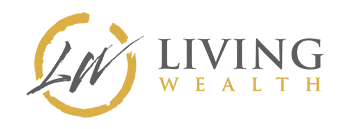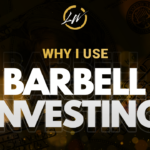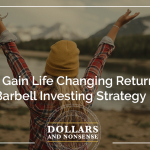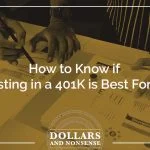Tune in to this Dollars and Nonsense episode to discover how Nate Scott leverages infinite banking and the “empire over retire” philosophy to build wealth, achieve financial freedom, and create a life of purpose and fulfillment.
Nate also does an in-depth explanation of the idea of barbell investing and how he leverages his policies to invest in asymmetrical opportunities. He shares personal examples of barbell deals he has created, such as investing in a friend’s business and partnering in the land flipping industry.
Key Takeaways:
- How to Get Real Results with Infinite Banking: Nate explains how infinite banking is not just a theoretical concept but a practical strategy that delivers concrete results. It’s all about transforming your money from a passive asset into an active tool.
- Empire Over Retire Philosophy: The “empire over retire” philosophy challenges conventional notions of retirement. It’s about crafting a life that doesn’t rely on traditional retirement but empowers you to build your own financial empire.
- Introduction to Barbell Investing: Nate introduces the concept of barbell investing, a strategic approach that involves placing funds into both safe, liquid, conservative assets and high-risk, high-reward opportunities. He also explains how infinite banking plays a pivotal role in executing this investment strategy.
- Barbell Deals for Entrepreneurs: Entrepreneurs have a unique advantage in creating barbell deals within their businesses. Nate shares personal examples of how he’s leveraged his infinite banking policies to participate in asymmetrical opportunities, such as investing in a friend’s business and venturing into the land flipping industry.
- Infinite Banking for Personal Expenses: Infinite banking can be used for personal expenses, such as home renovations and car purchases. It offers security and financial flexibility, making it an ideal choice for various life goals.
- Unlocking the Potential of Infinite Banking: Nate concludes the episode by underlining the remarkable potential of infinite banking as a wealth-building strategy. It not only provides security but also opens doors to high returns, making it an invaluable tool on the journey to financial success.
Episode Resources:
Gain FREE access to our Infinite Banking Course here
——————————————————————————————————————————
LIVING WEALTH PODCAST
DOLLARS AND NONSENSE: EPISODE 224 TRANSCRIPTION
Nate Scott [00:00]:
Infinite banking is not a scam. It’s not a get-rich-quick scheme. It’s a real strategy that produces real results. So in this episode, I want to share with the world exactly how I use my own infinite banking policies to build wealth and describe the real results I’ve experienced over the last twelve years of practicing infinite banking. This is dollars and nonsense. If you follow the herd, you will be slaughtered. You all right, everybody, welcome back to the show.
Nate Scott [00:28]:
We’re going to dive in today to maybe a more personal outlook on how I use my own policies. Of course, we’ve talked in this episode, in these podcast shows for forever, about the benefits and the perspectives that are required to practice banking at a high level. But I haven’t brought up too much just how I personally use it. What’s actually going on under the hood in Nate Scott’s life as he does infinite banking? And so I want to take some time today to dive into what I actually do with my policies.
It’s one thing to believe in infinite banking and learn about it through hypothetical examples and spreadsheets and illustrations. It’s another thing to hear a personal testimony of how somebody actually uses it and what they’re actually doing and the results they’re actually receiving. So I’m going to go ahead and dive in and describe the main areas of my life that infinite banking starts to impact, and that I’ve been using infinite banking to achieve real results. And the first thing that I want to say is that I believe that infinite banking fits so perfectly into my “empire over retire” philosophy.
Nate Scott [01:36]:
The idea, first off, that I don’t believe in the typical idea of retirement. I think that the typical conventional idea of retirement does more harm than good. And so I’ve contrasted that with the idea of what we call the empire method, which is the idea that I believe the number one goal for everybody, the number one financial goal that all of us should have, is to build a life that you don’t even need to retire from.
That’s what I actually think should be the ultimate goal financially, is to position yourself in such a way, position your business in such a way, position your investments in such a way, position your career in such a way, that you never feel this driving urge to hang up your hat and go live on an island and drink mai tais all day. So what I’m saying is, I believe that infinite banking does an amazing job at creating a world in which you don’t have to retire from and leveraging the policies to achieve that.
So, I bring this up to say, what do I use my policies to do? It is exactly that. So the vast majority of the time that I’m using policies, it is to make investments in things that I believe help me along what I call the empire path. And so how this looks is, and I’m going to describe the exact investments I made.
Nate Scott [02:47]:
But the reality is, I invest based on this idea that I got from a book called Antifragile. I read this book called Antifragile. In fact, a client told me to read the book Antifragile. So I read this book, Antifragile, and in that book, he’s talking about the idea of antifragility and how to create an antifragile life.
The whole concept is how to build your life in such a way that you can benefit from chaos, benefit from disorder. Things that gain from disorder is essentially the whole idea of Antifragile, and that we should be building our grand economy as the United States and our own personal economy to where nothing can shake it.
And so because of this, he promotes this idea called investing on the barbell, what I call Barbell investing, which I’ve done some podcast episodes on in the past, the idea of barbell investing, where essentially the idea is you only put money into the two opposite ends of the spectrum, and you stay out of the middle. Hence, the idea of a barbell.
Nate Scott [03:43]:
You have all of your money on two specific ends of a spectrum, one side being a safe, liquid, conservative, growing pool of money, which I believe that infinite banking is the best place to fit that end of the barbell. So one side of the barbell, where you put a lot of your resources, is in safe, liquid cash growing. There’s not a lot of volatility there.
Essentially, it’s your foundation, and you put all of your money on one end of the spectrum, and you only focus on investing, or you put your primary investing focus on what he would call a barbell investment, which exists on the other side, where he uses this word that hopefully you guys can follow along with me, called asymmetrical.
What this means is that on the other end of the spectrum, it’s not like we’re just gambling and throwing money at every, like, buying the lotto or something. That’s not the opposite end of the spectrum to the conservative, bulletproof pool of money that you’re building. It’s actually things that produce asymmetrical results where the risk of loss is relatively low compared to the potential for growth.
Nate Scott [04:56]:
And a lot of times, these asymmetrical opportunities where the risk of loss is relatively low, but the possibility for high return and potentially life changing returns exist on the barbell. And a lot of these deals are not what are called middle of the barbell deals, which are the ones that are often promoted that anybody could buy into. So you would put, like, stocks, bonds, retirement programs, mutual funds, even.
Maybe even, like, turnkey real estate and real estate syndications. Those are kind of middle of the barbell deals, where the potential for life changing results is relatively low. There’s some risk involved. You might end up losing money. They’re just kind of the middle of the barbell that you could lose money.
Nate Scott [05:39]:
And so what he’s saying is bypass all these middle. Where there’s no asymmetrical returns, the probability for loss, probability to gain are pretty equal. Maybe they’re not totally equal, but there’s just not very much possibility for huge returns in the middle of the barbell. So most of the barbell investments are created. They’re created by you. You become actively involved in various things. So I bring all this up.
Nate Scott [06:07]:
They say “Nate, what do you do with your policies?” I invest on the barbell. I go out and I work, and I earn income from being the president of Living Wealth and running this company and being an advisor in the infant banking space and receiving earnings from dealing with clients.
All of that income goes into policies which live on, which, for me, is fulfilling that one side of the barbell. It’s the conservative, safe, growing, liquid place that’s kind of unbreakable. It’s an antifragile world, by the way, things that gain from this order, life insurance companies have weathered every storm that they’ve ever experienced, whether it’s the great depression, the great recession, everything in between.
And the reason why I think it’s antifragile, gaining from chaos, is that I love when chaos occurs. Because when chaos occurs, when the stock market collapses, when the real estate bubble bursts, that is when barbell investing opportunities become rampant, where the asymmetrical opportunities become rampant, where the risk of loss is very low compared to the potential for upside. So, like, if you were to get into the real estate world at the post 2006-2007 real estate bubble bursting, or the post 2008 financial crisis in general, that would be a Barbell opportunity.
Nate Scott [07:18]:
Your risk of loss when properties were so cheap was incredibly low, but your risk for potentially a life changing result was extremely high. If you had lived your life on the barbell, you would have been able to take advantage of those opportunities. If all of your money was in the middle, you would have lost a whole bunch of money and you wouldn’t have been able to afford to get into that other side of things because you didn’t live your life on the barbell.
You were in a place that was volatile in and of itself, which is what a lot of people find themselves in most of the time. I invest, I use the policies as, like 90% of the time to invest in what I call Barbell strategies. So this is how it looks for me. I mean, here’s what I’ve actually done. So there’s a few things where there’s kind of an asymmetrical–
Nate Scott [07:57]:
The idea is this, by the way, on asymmetrical results is like, hey, if it doesn’t work out, I lost some money, but the risk of loss, or even the amount of money you could potentially lose is relatively low. If it does work out, it’s life changing. My life has changed forever. And this idea happens all the time.
If you happen to be a business owner, by the way, if you own a business or you’re an active investor in some way, essentially, if you’re an entrepreneur in any way, these types of deals exist. Like, the idea could be like, hey, a Barbell investment could be as simple as if I was to pay a consultant $20,000 to come give me some fresh ideas on how to run the company. It’s a Barbell because the cost is 20 grand, I’m willing to pay the cost. In fact, if it’s a business expense, then I get a deduction for the 20 grand.
Nate Scott [08:40]:
So my net cost is like twelve grand after taxes. So this is the amount of money I could lose. The reason why it’s a barbell is that I get one awesome idea or one awesome new strategy that could change the growth trajectory of the business and could even produce for me 20 grand a year of additional revenue for the rest of my life just by making this one suggestion that they made to me.
Then, of course, where are you going to find a place where you could put in a net after tax investment of twelve grand after tax? Like 20 grand minus the tax savings, because you had an expense. So I put in twelve grand after tax and I get 20 grand a year for the rest of my life in business. This is the idea of Barbell investing. And entrepreneurs and active investors and small business owners have a unique ability, just by the way, to take advantage of Barbell deals because they can be created easily within their own business structures. So here’s how it goes, or here’s how I personally do it.
Nate Scott [09:34]:
The idea is that oftentimes, so I’ve got about $500,000. Let’s just go into real scenarios. I’ve got about $500,000 invested with a buddy who’s probably going to listen to this podcast. In fact, I have even more than that invested with him. He’s awesome. Brian, shout out to you. It’s going extremely well. And I’ve loved doing business, but it was something that we worked out together.
Nate Scott [09:53]:
He’s in business, he was raising money, and he kind of had a set amount that was going to raise from investors. And I was like, hey, I’m not really interested per se in the rate of return that you’re offering to investors, just by itself. To me, that would be kind of a middle of the barbell deal. It doesn’t get me out of bed, doesn’t get me that excited, and I can put a little bit of money in, but I’m not going to go solve a big problem for you at that price or, I mean, at that rate of return. If we wanted to turn it into a barbell deal, if we wanted to turn it into a big. Create a deal, that essentially means I’ll fund the entire thing for you. It was about a million dollar raise. Instead of you having to go find new people to raise money from, I’ll solve the whole thing for you.
Nate Scott [10:37]:
If we can work out a deal that makes sense for both of us, that kind of turns into a Barbell deal for me. So, of course we worked it out, and I think he’s been loving it, and I’ve been loving it. And so it’s generating for me a high passive cash flow rate of return. But it was not a deal that’s just out there for anybody. It was created. It was, hey, I’m trying to raise some money.
Hey, is there a way that I could, because I’m so liquid, because I’ve lived my life on the barbell before I even knew about the book antifragile, because I had access to cash, I was able to negotiate terms to solve a big problem for someone else in business and in return receive better terms than would be the case if I was just going to put in a little bit of money. And so that’s one idea of how you create a barbell.
Nate Scott [11:19]:
So that’s one opportunity that I’m in. The other one is I got in and partnered with a partner in the land flipping world, which is kind of gaining some steam. This idea of land flipping, which I’m not going to go into that what it is in this podcast episode. But the idea of land flipping, where we’re buying land for under market value and then reselling it.
And it was an interesting concept and I got really intrigued with it, but I didn’t want to actively operate it myself. So I found some people in our local community who were already real estate agents, and I was like, “hey–” And they were looking to get into real estate investments. And I was like, I think this is an awesome way to get into real estate investing.
Nate Scott [12:01]:
In fact, I will fund the entire thing. I’ll help launch it. I’ll be there from the start. I’ll be an active participant in it to some degree. I’m just looking for someone else who’s going to do all the operating work and we’ll just split this business 50-50. And so I’m essentially actively funding land purchase and resale deals in that business, but very passively on my end, as far as my actual involvement in the day to day operations, somebody else is managing that completely.
The reason why this is a barbell opportunity, and the reason why I was so caught up in it, is that the cost of getting in the barrier of entry is actually relatively low. But if we gain traction and start to get deal flow coming in, the opportunity to be a life changing result, thus a barbell is very high.
Nate Scott [12:42]:
So the risk of loss, there’s asymmetry here is what I’m saying. Where the risk of loss in that world was relatively low, the risk of potential reward was very high. If things worked out. Once again, it’s starting a new business from scratch. That’s what we did. So it’s not like this is just some sort of middle of the barbell investment ideal that everyone’s in, that everyone could get into. So all that to say, I’m investing there. We also launched an Airbnb business and are doing some Airbnb rentals, we’re not that good at it just yet, so it’s not that profitable.
Nate Scott [13:09]:
But all that to say, those are where most of my dollars are going right now. And in the year 2024, when we’re doing this, all of those barbell investments that I’m using policies to fund are going to create on pace to create close to $200,000. I mean, that could even be a conservative number on essentially passive income that’s going to be created from investing in these deals. And you would be surprised at the amount of money.
I mean, I think the amount of money I’ve invested across all of them at any given moment in time is probably less than a million dollars total. And so I think the total, which is a lot of money to some, a lot of money to some people, maybe not a lot of money to a lot of other people. But the idea is it’s asymmetrical reward right now. I have technically very little risk involved in either of the three businesses that I’m in.
Nate Scott [14:01]:
I’m an investor in one and an owner in the other two. And that’s the primary. Where I put the vast bulk of my infinite banking cash values that are at work is in those three spaces. But all three of them have very low risk, but very high potential reward that I’m living.
And so I’m living my life on the barbell. That’s what I teach people to do. I think that if all I was doing was stuffing money in mutual funds and conventional retirement programs, I would never be achieving anything like what I’m achieving right now in this world of trying to create an Antifragile life. So that’s where the vast bulk of money goes.
Nate Scott [14:37]:
But it’s not only there. So some people say, Nate, do you only do investments? Well, the reality is infinite banking to me is the storehouse of capital. It’s where I put all of my liquid cash. So not only am I leveraging it to fund these various, what I call Barbell investments, where I’m highly focused on, but it’s also, I mean, we did a $50,000 basement remodel. I mean, finished out the basement, which is like 1100 sq ft of space. We did it really nice in our house. That was a couple of years ago. Of course, most people may go get a home equity line of credit or something like that to fund it.
Nate Scott [15:09]:
Of course, we were able to use our own banking system to fund it. The same thing goes with a deck project and hot tub that we just put in more recently this year that we’re able to fund from it. But it goes back to even using. Even when I was just starting out, I remember my wife and I– I had just started a policy the year before we got married, and it’s kind of expensive to put on a wedding and a honeymoon and all of this and buy engagement rings.
And I was able to use my policies to fund all of those little things at the start because that’s where all my cash was. I didn’t have cash sitting around in bank accounts, or I didn’t have to use credit cards. I was able to use policies to do that. So there is room for personal items as well, whether it’s a personal car, whether it’s house remodels and things like that, that I use policies to do as well.
Nate Scott [15:59]:
But I would say a couple of notes on that front that you hear some people talk about how they use their policies to purchase vehicles all the time, and they’re just running everything through the system. I’m not in that crowd at a high level. I’m not in that crowd at a high level. In fact, you’ve probably even heard me in the podcast say I have plenty of cash value to use to fund my own car purchases.
But sometimes I choose to continue using car financing from a bank if I want to keep that cash liquid in order to make investments. Like right now, we just bought a car just this last year, but I’m running this land flipping business. I got these other investments going on in these other places, and we bought a new, brand new Honda Odyssey because my wife loves minivans. And it was like 50,000 or 55,000 or something like that after everything was included.
Nate Scott [16:48]:
And I’m just merely saying I didn’t want to take $55,000 out of my policy to pay cash for this vehicle because I’d actually rather keep the $55,000 sitting in the policies ready to go in case we have a new land deal. And I wanted to be in a very liquid position, so I went ahead and just got a car loan from Honda to purchase the vehicle so I could keep my cash liquid.
Now, I’m not saying that’s always going to be the case. I have used policies to purchase cars in the past. I’m just merely saying there’s nothing magic about using policies. The truth of it is, and how everyone should set up their life, is that the policies serve this main purpose of, hey, I go out in the world, I earn income, I’m a saver, I live on less than I make, I produce capital. And all my capital I want to reside in policies.
Nate Scott [17:36]:
And then I’m going to leverage the policies to make investments or do big capital expenditures. Whether it’s like a basement remodel or putting on a deck in a hot tub, whatever it is in your life, whether it’s cars, you are totally free to do it. But there’s nothing magical about the policy loan features. We are just using the policy. The policy loan is just the best way to get the money out of the policy, the most efficient way to do so as you’re building capital in it. So once again, as we said in the intro, infinite banking is not a scam. It’s not a get rich quick scheme. There’s nothing magical about it.
Nate Scott [18:09]:
It’s a real world system that produces real results and it is extremely attractive to people who want a different way of building wealth. That would be more an entrepreneurial minded person like myself who is not too excited about just letting money sit someplace, who wants to build up money and use it to take advantage of awesome barbell, what I call it, opportunities that can be life changing.
So, it creates this antifragile outlook where I’ve got a lot of money in cash value. No one’s going to ever take that away from me. It’s the most secure foundational asset in the world, I believe essentially is policy cash value. And then on the other side of the spectrum, I have some very specific barbell investment deals that are producing high levels of cash value. I mean cash flow and passive income to me that are just going to create more and more wealth over time. On top of that, I just thought I’d let you know I did print off– I’ve got twelve policies and I still like having real paper as opposed to just online.
Nate Scott [19:13]:
And I added up all of the growth that I’m going to experience this year and across all policies, my profit for this year, on top of all the barbell investing and everything like that that I’m doing, I’m going to receive a $58,000 tax free growth above the premium. So of course I’m going to pay big premiums across the board, but I’m going to receive close to $60,000 of increase inside the policy.
That’s a real world thing that’s happening to me right now. I have clients who are more wealthy than me, who have bigger policies that have been around longer than I have, that are receiving even more than that. And of course we have some newer and smaller clients who are doing less than that. But that’s my real life right now. I’m going to pay all my premiums. All of that money is going to go into cash value plus a profit right now of $60,000 across, all twelve added together.
Nate Scott [20:03]:
And so this system, it’s real, it works. I mean, I’m having fun doing it. Is it the only way to build wealth? No. Is it the best way to build wealth? Who’s to say, objectively speaking, only fortune tellers apparently know what the best way to build wealth is. But is it a real strategy that produces real results in lives, especially for the people who want to get their hands on their money and not lock it up and set it aside for later, but want to actually use it right now to achieve real things.
Yes, it’s the best thing that I know of in my background to achieve the results that I’m getting and live your life what I call in the barbell, in an antifragile way with very little risk, very high return. So I hope this has been helpful to you once again. This strategy may not work for everybody, but it works awesome for people like me.
Nate Scott [20:54]:
And I’m happy if anyone out there listens to this and says, I’m kind of like Nate, I want to be like Nate. Come work with me. We’re happy to have you. Thank you guys so much for being here. This has been Dollars and Nonsense. If you follow the herd, you will be slaughtered.
And also, remember, guys, if you go to livingwealth.com/escapethebank, you can sign up for free for our infinite banking course, the course that I believe is probably the best course to get you understanding infinite banking at a high level available. So go to livingwealth.com/escapethebank, and we’ll see you there.








